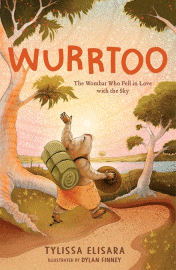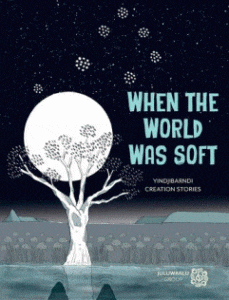
Wurrtoo: The Wombat Who Fell in Love with the Sky
Wurrtoo: The Wombat Who Fell in Love with the Sky
Tylissa Elisara
Dylan Finney
Lothian, 2024
185pp., hbk., RRP $A19.99
9780734421982
In the fifty-fifth burrow of Bushland Avenue in a beautiful clearing on Kangaroo Island where the arching gum trees kiss, is the home of Wurtoo, the hariy-nosed wombat. His is the one at the end with the big red trapdoor and large gold doorknob and a myriad of tunnels because he loves to extend it, so much so that it can take awhile for him to get to his front door. It even has a library where he has just four books that he cherishes – a book of fairytales that has taught him all about love; a plant encyclopedia that told him where to find his favourite muntrie berries and wattleseeds; a cookbook which helps him make them into something delicious, and a fourth, his favourite, which had stories as old as time and in particular, a map of a most sacred place, the Forest of Dreaming. And it fuelled his dream to follow the map across the water to the mainland, climb the ancient tree to the heavens, and marry the love of his life, the sky.
But first, he needs to find the courage because right now, he can barely leave the burrow without his nerves getting the better of him, because having led such a solitary life, the thought of meeting other creatures terrified him. And so , despite being nocturnal by nature, he chooses to go out in the daytime so he can be unseen, and each day he makes a pilgrimage to the lighthouse for a picnic.Little does he know, that on this particular day his life will change forever because he inadvertently saves Kuula the koala from a bushfire, and acquires the adventure companion he didn’t know he needed.
With Kuula by his side, Wurrtoo finds the courage to leave the safety of his burrow and sets out on an epic journey to cross the island, reach the mainland and climb to the top of tallest tree in the Forest of Dreaming. But it’s fire season, and danger and strange creatures lurk behind every gum tree. To make it, the pair must face their fears together, learn the importance of friendship and discover the power of wombat wishes.
Described as an “Indigenous Blinky Bill meets Winnie the Pooh”, this heartwarming and beautifully illustrated novel for independent readers by the 2021 black&write! fellow Tylissa Elisara, and it is worth reading for the power of the descriptions of the landscape alone. Immediately, the reader is transported into Wurtoo’s world, akin to Tolkien’s description of the home of Bilbo Baggins, and relate to his ambitions, desires and fears. It is one for those readers who love adventures and quests, and with traditional First Nation stories, knowledge, food and culture woven seamlessly into the tale, it becomes one that not only engages and entertains, but helps the non-indigenous reader better understand that incredible connection to Country that exists for those who are.
There is also the underlying universal theme of building trust, facing your fears, accepting those you meet for who they are, so friendships are built on similarities rather than differences, that will speak to many readers, perhaps encouraging them to think that if Wurrtoo can do this, so can they.
For me, the mark of a story that works, is hearing myself read it aloud to a class of students, and this one is one of those rare ones. So with teachers’ notes available to enhance and enrich the experience, this is definitely recommended as a read-aloud for Years 3-4. Something different, inspiring and Australian.
